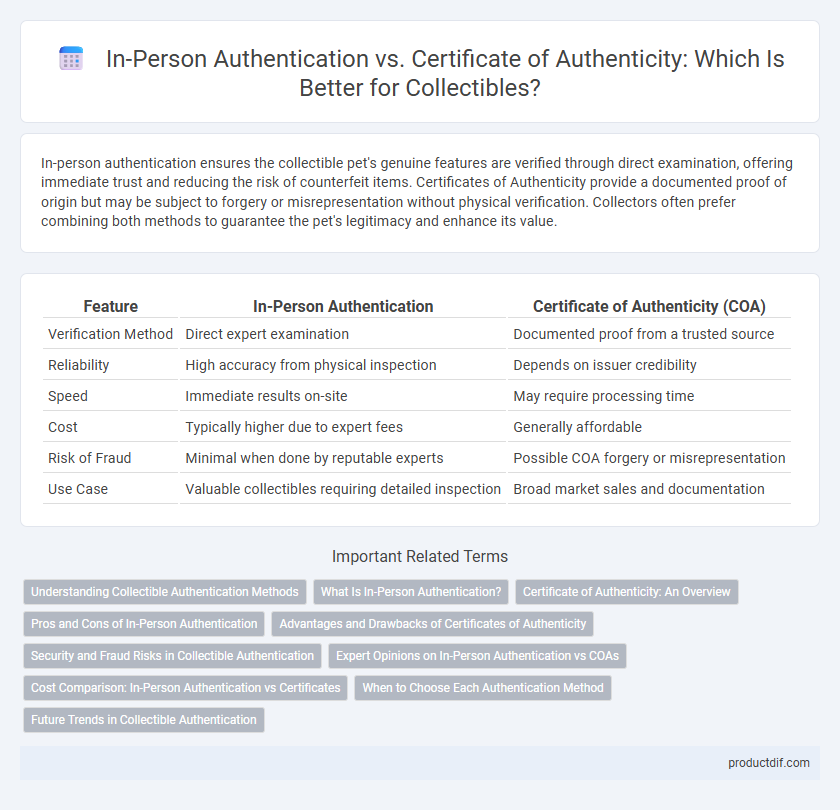In-person authentication ensures the collectible pet's genuine features are verified through direct examination, offering immediate trust and reducing the risk of counterfeit items. Certificates of Authenticity provide a documented proof of origin but may be subject to forgery or misrepresentation without physical verification. Collectors often prefer combining both methods to guarantee the pet's legitimacy and enhance its value.
Table of Comparison
| Feature | In-Person Authentication | Certificate of Authenticity (COA) |
|---|---|---|
| Verification Method | Direct expert examination | Documented proof from a trusted source |
| Reliability | High accuracy from physical inspection | Depends on issuer credibility |
| Speed | Immediate results on-site | May require processing time |
| Cost | Typically higher due to expert fees | Generally affordable |
| Risk of Fraud | Minimal when done by reputable experts | Possible COA forgery or misrepresentation |
| Use Case | Valuable collectibles requiring detailed inspection | Broad market sales and documentation |
Understanding Collectible Authentication Methods
In-person authentication offers direct verification by experts who examine the collectible's physical attributes, ensuring its originality through hands-on analysis. Certificates of Authenticity provide documented proof from reputable sources, serving as written guarantees that accompany the collectible. Both methods play crucial roles in establishing provenance and enhancing a collectible's value within the market.
What Is In-Person Authentication?
In-person authentication for collectibles involves a direct examination by an expert to verify the item's genuineness, utilizing physical inspection techniques such as magnification, UV light analysis, and comparison to known original pieces. This method offers immediate validation by experienced professionals who can detect subtle signs of forgery or alterations that certificates may overlook. It provides higher confidence for collectors, as the tangible presence of an expert reduces the risk associated with counterfeit items.
Certificate of Authenticity: An Overview
Certificates of Authenticity (COAs) serve as formal documents verifying the legitimacy of collectibles, providing crucial details about provenance, artist, and condition. Unlike in-person authentication, COAs offer a tangible proof that can enhance a collectible's value and buyer confidence. Securely issued by reputable experts or organizations, COAs reduce risks of fraud and simplify transactions in the collectibles market.
Pros and Cons of In-Person Authentication
In-person authentication offers immediate verification of a collectible's legitimacy through direct expert inspection, reducing the risk of counterfeit items. It provides a tactile evaluation that certificates of authenticity (COAs) may lack, ensuring the item's condition and provenance are accurately assessed. However, the process can be time-consuming, costly, and limited by the availability of qualified experts, making it less accessible compared to COAs.
Advantages and Drawbacks of Certificates of Authenticity
Certificates of Authenticity (COAs) provide a tangible verification of an item's origin and legitimacy, reducing the risk of counterfeit collectibles and enhancing buyer confidence. However, COAs can be forged or manipulated, making them less reliable than in-person authentication by experts who physically examine the item's unique characteristics. Furthermore, COAs often lack standardization and legal enforcement, which may limit their credibility in high-value collectible transactions.
Security and Fraud Risks in Collectible Authentication
In-person authentication provides a high level of security by allowing experts to physically inspect collectibles, reducing the risk of fraud through direct examination of material, craftsmanship, and provenance. Certificates of Authenticity (COAs) can be forged or misrepresented, increasing vulnerability to counterfeit collectibles and fraudulent claims. Combining both methods enhances overall trust, but relying solely on COAs may expose collectors to higher fraud risks.
Expert Opinions on In-Person Authentication vs COAs
Experts emphasize that in-person authentication provides direct verification by specialists who assess physical attributes, provenance, and authenticity markers, reducing the risk of forgery compared to Certificates of Authenticity (COAs). While COAs can offer a documented guarantee, their reliability varies widely depending on the issuer's credibility and expertise. Collectors often prioritize in-person evaluations as the gold standard for ensuring genuine collectibles, especially in high-value transactions.
Cost Comparison: In-Person Authentication vs Certificates
In-person authentication typically incurs higher costs due to expert fees, travel expenses, and time investment, often ranging from $200 to over $1,000 depending on the item and expert reputation. Certificates of Authenticity (COAs) offer a more affordable alternative, usually priced between $20 and $100, but risks of forgery and less reliable verification persist. Collectors weigh cost-effectiveness against credibility, favoring in-person authentication for high-value collectibles and COAs for lower-value items or initial verification.
When to Choose Each Authentication Method
In-person authentication is essential for high-value collectibles requiring expert verification to prevent fraud, especially during auctions or private sales. Certificates of Authenticity are suitable for lower-risk transactions or items with a trusted provenance, offering convenient proof without physical inspection. Choose in-person authentication when immediate, reliable expert validation is needed, and opt for certificates for ease and confidence in established collectible markets.
Future Trends in Collectible Authentication
Future trends in collectible authentication emphasize hybrid methods combining in-person authentication with digital Certificates of Authenticity (CoA) powered by blockchain technology to enhance transparency and prevent forgery. Experts predict widespread adoption of AI-driven image analysis tools to verify the provenance and condition of collectibles with greater accuracy and speed. Integration of augmented reality (AR) platforms will allow collectors to access real-time authentication details, fostering trust and engagement in the evolving market.
In-Person Authentication vs Certificate of Authenticity Infographic

 productdif.com
productdif.com